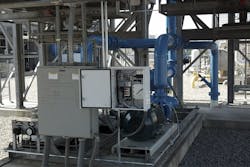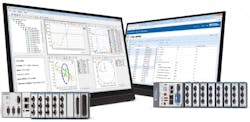The Internet of Things (IoT) connects billions of people through software apps such as Twitter and WhatsApp and platforms such as iOS and Android. IoT concepts and low-level technology are bleeding into the industrial space and boosting business efficiency. The Industrial Internet of Things (IIoT) will eventually connect tens of billions of "things" businesses use to operate with other machines, the cloud, control systems and people.
Pumps are squarely on the list of "things," and like many other big-iron assets that do not generate high-tech publicity, they have much to gain with this surge of technology. Why do we need IIoT pumps? What does an IIoT-enabled pump look like?
Pump challenges
Uptime is under fire from evolving challenges that add risk and cost to operations. However, as fossil power-generation plants continually seek ways to improve performance and reduce costs, online condition monitoring is being implemented to help address scaling monitoring for critical assets and balanced plant equipment. This improves the reliability and uptime across the entire power plant. Although pumps are a "thing" to be monitored, potential applications are numerous and include thermal performance and monitoring, emissions monitoring, equipment condition monitoring, system performance and alarm management, and data trending.
Further compounding this uptime problem is the fast-approaching retirement age of many of the maintenance professionals responsible for keeping motors, pumps and drives operational. They retire and immediately turn to private consulting because of the current industry demand fueled by the lack of qualified professionals to replace them. This is especially difficult considering a portion of a maintenance professional’s time is spent on a route in transit between assets to take manual measurements. Fewer maintenance personnel in the field means the ones who are there spend even more of their time gathering data, much of which is from healthy, operational assets. The goal is to find the problems before costly downtime and measuring healthy assets is part of the price paid to reduce that risk.
Another challenge involves the age of the commissioned assets. Older motors and pumps can cost more to keep running and increase the risk of an unplanned outage. In short, more assets need to be monitored more often when fewer professionals are available in the industry to keep them operating. For process industries, the health of pumps, motors and drives can be the difference between a smooth shift and a costly, unplanned outage. To avoid unplanned downtime, reliability and availability are staples of safe power plant operations. Maintaining equipment, such as pumps, to high-performance standards improves the understanding of pump degradation. A key factor in maintaining high reliability is the use of advanced, online monitoring technologies that allow for the continuous monitoring of plant processes.
An example of IIoT software focused on improving asset uptime
According to the U.S. Energy Information Administration, U.S. power-generation fleet components vary in age. Hydropower generators tend to be the oldest, with nuclear generators right behind them. In contrast, most new capacity includes natural gas-fired power plants and the renewable resources, primarily wind, coming online in the 2000s. Monitoring technologies across a distributed network detect potential problems and provide warnings of equipment failure or performance degradations.
A new solution
IIoT technology addresses these challenges using technology such as edge computing, analytics, cloud access and mobile device support. Ten years ago, this technology was costly, and the severity of these challenges was low. Today Moore’s law, software platforms, the cloud and connected devices are inspiring smarter maintenance plans. Recently at the Offshore Technology Conference 2016 in Houston, four companies showcased an intelligent pump to demonstrate a variety of technologies that address industry challenges and help businesses operate more efficiently.
The process of automatically monitoring this pump begins with a variety of sensor technologies. The pump is outfitted with multiple sensors that measure vibration, voltage, current, temperature, pressure and flow rate. IIoT gateways designed to connect operational technology to information technology, specifically for brownfield applications, need to be open enough to support a range of sensors, including new sensor technologies as they are merged into the IIoT platform. For this demo, a single intelligent gateway aggregates data from all of the connected sensors and chooses whether to conduct local processing at the asset for event triggers and alarms.
By shifting from a manual-route-based maintenance routine to one that uses online monitoring for critical and near-critical assets, businesses can monitor more machines more often and enable their workforces to spend more time diagnosing and managing assets instead of walking or driving around to take measurements. The ability to compute power on the asset can help analyze the data in near real time and improve the probability of catching transient phenomena. This ability also reduces the required network bandwidth because dynamic measurements such as vibration are often run at tens of thousands of samples per second. There is no reason to excessively stream megabytes of data from a healthy pump all the way to the cloud.
The advanced pump technology demonstration, as seen at OTC 2016, shows a future of self-diagnosing assets that increase uptime and reduce operating cost.
This advanced pump-monitoring system also features an analytics engine that can perform both diagnostic and prognostic calculations on the pump. These are IIoT terms for "What’s going to break?" and "When will it break?" If the job of the maintenance engineers at a water treatment or power plant is to keep things running, then a system that tells them exactly what is wrong and how long they have to fix it is useful. These analytic engines require hardware with more power of computation than typical sensor gateways and monitoring systems offer today. Some heavier-compute-power hardware for the next generation of IIoT systems is keeping bandwidth and information latency in mind by moving closer to "the edge" where data is acquired. These more rugged server platforms allow businesses to acquire actionable intelligence with less bandwidth use for a more efficient bridging of information technology and operational technology. That is a another way of saying, "You get only what you need only when you need it" from your asset health monitoring system.
Multifaceted platform
IIoT software platforms help manage vast sets of data and deliver it as actionable information to business operators. In this demo, the IIoT software platform aggregates data from the sensor gateway and the analytics engine for display on a higher-level dashboard that provides informative features regarding the health of the pump. These features include the total dynamic head, power and best pump efficiency numbers as well as diagnostic and prognostic information.
With a smaller experienced group of maintenance professionals who will not have to travel as much, large companies can access this information from anywhere in the world and keep an eye on asset health. Smaller organizations that lack maintenance groups of their own can use this technology to communicate with remote consulting services experts. The paid experts can log on to a server and see every asset under contract.
When companies need to service failing assets, they can use this same platform to connect to augmented reality systems. The systems help on-site maintenance technicians see sensor readings, diagnostic information and even service manual procedures from a wearable headset while looking at the asset.
Maintenance technicians can reasonably expect that the intelligent analytics they use in the future to diagnose failures will connect to procurement software to automatically order the part. The IoT can be used to order laundry detergent with the press of a button, and the IIoT will order bearings and seals automatically. IIoT technology offers not only efficiency gains for pumps and other heavy assets right now, but also a lot of headroom for innovation and further benefits.
Brett Burger joined National Instruments (NI) in 2003 after graduating with a degree in aerospace engineering from Texas A&M University. He started his career as an applications engineer in the Engineering Leadership Program, where he supported LabVIEW customers in the platinum support queue and eventually became a team lead for new support engineers. Since then, Burger has presented at numerous NI technical events and customer locations and on the main keynote stage at NI Week 2010. Today, as a principal marketing manager, he focuses on IoT technologies for monitoring solutions. For more information about NI, visit ni.com.




